Methodology for Assessing the Risks of Terrorism
Nikolay A. Makhutov
Institute of Mechanical Engineering of the Russian Academy of Sciences
INTRODUCTION
Through the efforts of specialists from many countries, a broad scientific base has now been created for analyzing and classifying the risks of extreme situations of a natural and technogenic nature, studying scenarios by which they might begin and develop, and reducing the vulnerability of high-risk sites with regard to natural and technogenic disasters.1 This scientific base must be used as widely as possible in efforts to ensure security against the impacts of terrorism.
This approach to analyzing terrorism-related risks presupposes that emergency situations initiated by terrorist acts develop according to laws analogous to the development of ordinary emergency situations caused by natural or industrial disasters. Therefore, they may be analyzed using methods and models used in addressing classical problems in risk and safety theory.
The threat of terrorist acts must be included in the system of studies of possible scenarios of how emergency situations might develop. In particular, event trees used in risk analysis at critically important infrastructure sites must be augmented with scenarios taking into account possibilities of terrorist attacks, which substantially change the scenarios themselves as the structure of primary initiating factors in emergency situations. They also lead to the creation of cascading processes in the development of accidents and catastrophes with the most serious losses to the population, economic objects, and other vital resources.
We need to include the analysis of terrorism risks and terrorist mechanisms for initiating extreme situations in the range of problems being considered. This requires developing and adapting existing models and methods for studying catastrophes so that they account for the special characteristics of their initiation by unauthorized and terrorist actions that could be taken to strike at the most vulnerable and significant targets critically important for the national security infrastructure.
In order to analyze risk and security with the possibility of terrorist actions, it is first necessary to compare the initiation stage of the extreme situation through terrorist actions and the changes and structure of impact factors of the terrorist act with those in a traditional emergency caused by a natural or industrial disaster.
It should also be noted that the modern strategy for ensuring natural and industrial safety, which calls for focusing efforts not on eliminating the consequences of extreme situations but on predicting and preventing them, must also be extended to cover situations in which emergencies are triggered through terrorist actions. In this case, scientific developments regarding methods for managing the risks of terrorism must be accorded great significance in integrated risk management mechanisms.
CLASSIFICATION OF ACCIDENTS AND CATASTROPHIC SITUATIONS
The failure to provide for basic characteristics of reliability, resources, and safety regarding a range of criteria and reserve capacities leads to the possibility of accidents and catastrophic situations arising and developing at all stages of the creation and exploitation of complex technical systems. Over the past decade, institutes of the Russian Academy of Sciences and the Russian Ministry of Emergency Situations, Ministry of Industry and Science, State Mining and Industrial Inspectorate,2 Atomic Energy Inspectorate, and Ministry of Education have synthesized a substantial volume of fundamental information on accidents and catastrophes of an industrial, natural/industrial, and natural character as part of the State Scientific-Technical Program for Safety for the Population and Economic Objects Considering the Risk of Natural and Industrial Disasters (SSTP Safety). In carrying out this program, participants analyzed and generalized information on the basic characteristics, conditions, and scenarios for the outbreak of accidents and catastrophes in the natural and industrial spheres engendered by complex dangerous phenomena and processes in various regions of the world. Potentially dangerous facilities and natural processes might create catastrophes in the
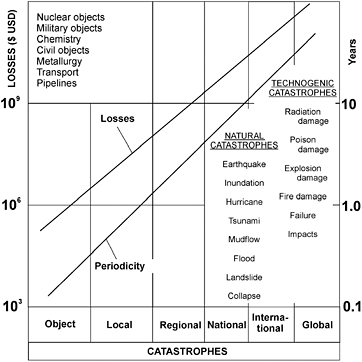
FIGURE 1 Losses and periodicity of natural and technogenic catastrophes.
following classes: planetary, global, national, regional, local, facility-level, and localized (Figure 1). The potential damages and periodicity of occurrence were evaluated depending on the class of accidents and catastrophes (beginning with global and ending with localized).
Official documents in the Russian Federation use six classes of catastrophes: transborder (equivalent to global), federal (equivalent to national), regional, local, facility-level, and localized.
Based on the results of this summary analysis, a classification of catastrophes was constructed, taking into account the damages U and the periodicity ΔT of their occurrence (see Table 1). Here the magnitude U for each catastrophe decreases from 1 × 1010 to 5 × 103 dollars, while the periodicity of their occurrence declines from 5 × 102 to 8 × 10–2 years. Thus the variation in damages (dollars per catastrophe) for various types of disasters could reach seven orders of magnitude, while that of the probability of occurrence P = 1/ΔT (1/year) could reach three orders of magnitude.
The concept of risk is the key one in resolving problems related to ensuring security. This paper includes a number of simplified equations that are used for assessing risks and risk factors. These include a basic equation for risk assess-
TABLE 1 Characteristics of Risks of Accidents and Catastrophes
|
No. |
Class of accidents and catastrophes |
P (1/year) |
U (dollars) |
R (dollars/year) |
|
1 |
Localized |
5.0 × 100 |
5.0 × 103 |
2.5 × 104 |
|
2 |
Facility level |
1.2 × 100 |
4.0 × 105 |
4.8 × 105 |
|
3 |
Local |
5.0 × 10–1 |
7.0 × 106 |
3.5 × 106 |
|
4 |
Regional |
1.6 × 10–1 |
1.0 × 108 |
1.6 × 107 |
|
5 |
National |
1.2 × 10–1 |
1.5 × 109 |
1.8 × 108 |
|
6 |
Global |
8.0 × 10–2 |
1.0 × 1010 |
8.0 × 108 |
ment (Formula 1), equations for assessing risk components (Formulas 7–13), and an equation for assessing risk management (Formula 14).
Risk is defined by means of the functional FR of the probability that a catastrophe (natural or technogenic) will occur and the magnitude of the damage:
(Formula 1)
where R represents the risk associated with a natural or technogenic catastrophe; P, its likelihood; and U, its consequences (Formula 1).
The risks vary within the bounds of four orders of magnitude. For Russia the probability of the occurrence of national and regional natural-technogenic extreme situations differ by 1.4 times and are approximately an order of magnitude lower than the risk for local situations; the likelihood of local and facility-level accidents differs by 5 times.
The results of the studies that have been conducted have been reflected in the fundamental multivolume series Russia’s Safety3 and in issues of the journal Problems of Safety and Emergency Situations.4
The assessment of the probability P, damages U, and risks R of accidents and catastrophic situations involves a group of risk identification methods, including various methods for analyzing statistical information on natural and technogenic catastrophes of a particular type in the region being studied, as well as methods for analyzing the reliability of equipment and technological processes and the effectiveness of management and control. Methods for calculating the magnitude of damage substantially differ for various technical facilities and natural systems. Therefore, specialists in Russia and other countries are currently
developing a group of special methods aimed at analyzing natural-technogenic processes capable of leading to accidents and catastrophic situations.
In assessing risk R in natural-technogenic-social systems, great importance lies in integrated (complex) risks, including the risks Ri from diverse factors operating on various temporal and spatial scales.
Integrated risks are determined by the specific nature of the interactions of the natural, technogenic, and social spheres. Terrorism could substantially change both the magnitudes of the risks Ri and R themselves and the nature of this interaction.
TYPES OF TERRORISM AND IMPACTING FACTORS
Modern terrorism may be divided into three types: traditional, technological, and intellectual (see Figure 2).
Traditional terrorism has been and remains aimed at the physical elimination (murder, abduction) of representatives of state and social structures and of average citizens to achieve certain social, economic, and political goals. In this case the actions of terrorists are directed against individuals and are carried out by organizing bombings, arsons, poisonings, kidnappings, and so forth. Here the
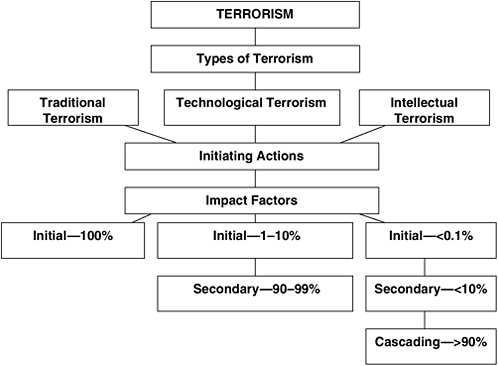
FIGURE 2 Types of terrorism and impact factors.
fundamental damages are inflicted at the stage of the initial impacts of the terrorist acts.
Technological terrorism is represented by actions aimed against infrastructure targets critical to national security or committed using especially dangerous technologies, devices, and materials. With technological terrorism, the initial impact factors of the terrorist acts create technogenic accidents and catastrophes with a significantly greater (tens and hundreds of times) level of secondary impact factors that affect the targets attacked, their personnel, the population, and the environment. That is, in contrast to traditional terrorism, with technological terrorism the initial damages represent only an insignificant portion of the total damage compared with the secondary impact factors.
Intellectual terrorism is a type of terrorism in which the initial impact factors might be specially inserted in regulatory or technical documents and design engineering elements in the creation of new facilities in the technosphere or the operation of existing ones. These factors are capable of creating secondary impacts and damages leading to a cascade of tertiary impact factors.
The appearance and development of primary, secondary, and cascading impact factors of terrorism are subject to practically the same natural processes that shape traditional accidents and catastrophes at technosphere facilities that create extreme situations of a technogenic nature. This circumstance makes it possible to apply the scientific base developed for ensuring natural-technogenic security to addressing issues related to reducing the risks of terrorist impacts and countering terrorist threats.
In this regard the development of methods for analyzing the risks of terrorism and of means and systems for protecting against terrorist threats comes down to two basic problems:
-
reducing the risks R by preventing initiating dangers, threats, and challenges
-
reducing the risks R that extreme situations of a technogenic nature may develop if initiating factors do occur by redistributing a number of impact factors
FUNDAMENTALS OF DETERMINING THE RISKS OF TERRORISM
The theory of the security of complex social-natural-technogenic systems accords a substantial place to methods and means of analyzing crisis phenomena and processes, accidents, and catastrophes (their classification, potential dangers, and criteria base); basic scientific disciplines for describing scenarios regarding the occurrence and development of crises, accidents, and catastrophic situations; and comprehensive consideration of the interactions of the elements of the human/critically-important-object/environment system.
Comprehensive security determines the degree to which people, objects, and
the environment are protected against threats from various sources—from people themselves, from created and functioning complex technical systems, and from important natural impacts—in the occurrence and development of accidents and catastrophic situations.
Assessment of the potential danger of human actions by staff, unauthorized outsiders, and terrorists; high-risk facilities; and natural processes, taking into account various types of accident scenarios, must be carried out using the following three characteristic parameters: (1) accumulated energy reserves, (2) reserves of potentially dangerous substances (those presenting radiation, chemical, and biological hazards), and (3) information volumes and flows.
An important area of research in both overall catastrophe theory and terrorism risk assessment is the study of areas of dangerous and safe conditions, processes of damage accumulation, reactions of structural elements to external and internal effects, and development of maximal condition theory and especially of the process of postcritical behavior of system elements that leads to various consequences.
Taking into account a generalization of the basic factors involved in the occurrence of accidents and catastrophes, we may take the following as determinant:
-
uncontrolled release of energy E (thermal, mechanical, blast wave, electromagnetic)
-
uncontrolled release of the above-listed dangerous substances W
-
uncontrolled dissemination or disruption of information flows I (management, informational, warning)
Given what has been outlined above, it is possible to construct areas of dangerous and safe conditions for various natural-technogenic-social systems (Figure 3) in which a situation could move into the danger zone in accordance with the laws governing random and determinate processes v(t). The risks RE, RW, and RI may be determined as follows in Formula 2 for each of the groups of catastrophe impact factors (E, W, I) based on Formula 1:
(Formula 2)
The fundamental special feature of terrorism risks according to Figure 3 is that a common random process v(t) is replaced on the radius-vector r(t) by the nonrandom, directed selection of the direction r(t) and time tTR of the manifestation of the most dangerous damage factor characteristic of the given critical infrastructure site or natural process. In this case the catastrophe initiated by a terrorist act is realized on a substantially shorter time interval tTR not linked with the time to needed to achieve a dangerous condition according to existing design norms and operating rules for the potentially dangerous facility. The time trajec-
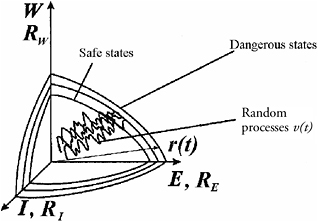
FIGURE 3 Areas of dangerous and safe states.
tory of the random process for regular functioning v(t) becomes substantially longer than the time vector r(t). Thus in analyzing the risks of terrorism, the determining correlations may be written as follows in Formula 3:
(Formula 3)
Four risk groups may be included in the overall risk structure R: systemic Rs, integrated Ri, differentiated (complex) Rd, and object (elemental) Re. Here the risks in the previous group are elements of the following (Formula 4).
(Formula 4)
The risks of terrorism RTR are components in all four risk groups. Each risk group can have its own corresponding level of management of the elements of national security: federal (Rs), regional (Ri), industrywide (Rd), and facility-level (Re). Regarding critical infrastructure sites, the occurrence of accidents and catastrophes is associated with the realization of risks Re; this subsequently has an impact on the entire further sequence of risks (Re→Rd→Ri→Rs).
Formula 1 may be used to monitor and forecast each of the types of risk listed.
If one analyzes the systemic risks of natural and technogenic catastrophes (or risks of extreme situations of a natural and technogenic character), then taking these into account in determining the probability of systemic threats using the functional FPS, we may write Formula 5 as follows:
(Formula 5)
where PN is the probability of occurrence of an unfavorable event occasioned by the human factor, PT is the probability occasioned by the status of objects in the technosphere, and Po is the probability occasioned by environmental effects.
The form of the function in Formula 5 also remains the same for the probabilities of the realization of systemic Ps, integrated Pi, differentiated Pd, and facility-level Pe risks.
The significance here is that the role of the human factor in the assessment of Ps given changes in PN is determined not only by the operators PNO and personnel PNP (as usually happens for Pd) but also by the individuals PND who are making decisions at all levels involved in state management of national and international security. The probabilities PN, PNO, PNP, and PND comprise an interconnected complex that is also characteristic in the analysis of risks without considering terrorism.
(Formula 6)
The probability of terrorism PNTR as one manifestation of the human factor is a function independently included in PN and is also connected with the actions of the operators, personnel, and managers.
(Formula 7)
The probabilities PT are substantially dependent on the level of protection of the given critical infrastructure site from accidents and catastrophes. This protection is determined by the degree of degradation of the facility at a given stage of operation (t < to) with the level of diagnostic inspection and monitoring. Such a situation highlights the direct interrelation of the parameters PT and PN. Analogous to Formula 7, with acts of technological terrorism we may write the following:
(Formula 8)
It is well known that probabilities P0 depend on manifestations of dangerous natural processes, on the condition of the critical infrastructure site, and consequently on PT . Here the probability of terrorist impacts on special facilities in the technosphere (dams, mines, dangerous chemical storage facilities, mine tailing dumps at mining complexes) and on their operators and personnel also increases P0.
(Formula 9)
Damages US from the realization of systemic threats can generally be written through the function FUS
(Formula 10)
where UN is the damages inflicted on the population by the interaction of primary and secondary impact factors in the realization of systemic threats, UT is the damages inflicted on facilities in the technosphere, and UO is the damages inflicted on the environment.
The magnitudes of UN, UT, and UO may change in natural units (for example, by the number of people killed, the number of buildings destroyed, and the land area harmed) and in equivalents (for example, in economic and monetary indicators).
Terrorist acts are primarily manifested in increasing statistics regarding victims of the terrorist acts themselves UNTR.
(Formula 11)
As noted earlier, with terrorist acts, damages to objects in the technosphere UT and the natural environment UO increase from manifestations of secondary and cascade impact factors.
(Formula 12)
(Formula 13)
In Russia, considering the socioeconomic transformations, the basic characteristics of the risks R of natural and technogenic accidents and catastrophes as defined by their severity T (or damages U) and numbers N (or probability P) are generally relatively complex in nature regarding their change over time t with an overall tendency toward increasing (see Figure 4).
The exceptional feature of the risks of terrorist incidents over the past 10 years is that the growth of the magnitude of the risks R, the probability of their occurrence P, and their damages U as measured in the number of victims is proceeding 5–10 times more intensively than the increase in the risks, probability, and damages for natural, natural-technogenic, and technogenic extreme situations.
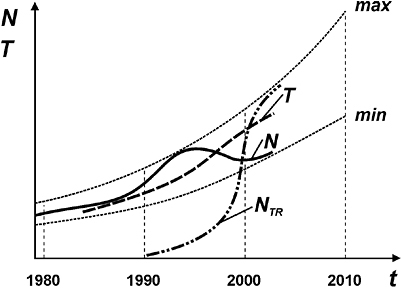
FIGURE 4 Change over time in the number N and severity T of catastrophes.
National, regional, and facility-level management, regulation, and security efforts according to systemic risk criteria Rs feeds into a qualitative and quantitative probabilistic, statistical, and deterministic analysis for the given time period Δt of all parameters in Formulas 1–13 and implementation of comprehensive measures to reduce systemic risks from the actual unacceptable levels RS to acceptable (allowable) levels [RS ]:
(Formula 14)
where ns is the safety coefficient for systemic risks, [PS] and [US] are the acceptable (allowable) probabilities and damages, Z is expenditures for risk reduction, and mz is expenditure effectiveness (1 ≤ mz ≤ 10).
Security according to the risk criteria RS may be considered assured if the inequality nS ≥ 1 is achieved.
For Russia, based on fundamental risk indicators, the magnitudes of nS are extremely low at present (no more than 0.1).
The time period Δt for which it is possible to determine risks RS is generally taken at 1 year (Δt = 1 year).
In accordance with Formula 14, management of security and planning for its improvement using a risk-based set of criteria leads to the following primary tasks:
-
developing scientific methods for analyzing risks RS and their basic parameters PS and US according to the system comprised by Formulas 1–6 and 10
-
deciding on the level of acceptable magnitudes [Rs], [Ps], and[Us] while assessing the magnitudes of reserve resources ns
-
making a scientifically based determination of the level of expenditures Z for risk reduction while selecting and increasing the effectiveness of these expenditures (mz)
In managing the risk of terrorism RSTR according to Formula 14, the characteristics UNTR, PNTR, UTTR, PTTR, UOTR, and POTR must first be singled out and determined according to Formulas 7–9 and 11–13. These characteristics necessitate separating out the component ZTR for the reduction of risks RSTR along with its expenditure effectiveness mZTR from overall risk reduction expenditures Z.
Here, predicting, monitoring, and preventing accidents and catastrophes at critical facilities turn out to be substantially more efficient than eliminating the consequences of emergency situations. With the appropriate foundations for risk reduction measures, the magnitudes Z can be significantly lower (mz times) than the damages USTR inflicted on the economy by the unprotectedness of critical facilities against terrorist acts.
In developing the fundamentals of state policy, the regulatory and legal base, draft plans for federal programs and pilot industry-wide and facility-wide projects to protect critical facilities, the population, and the vital infrastructure against threats of a technogenic, natural, and terrorist nature, the following areas of scientific research and development have the greatest significance:
-
developing a base of scientific criteria for assessing the status of critical facilities and preparing a state registry of such facilities appropriate for protection against terrorist actions
-
creating scientific foundations and principles for the design, construction, and operation of facilities and building systems for their protection
-
creating theories and methods for control, diagnostics, monitoring, and forecasting of terrorism risks for critical facilities, operators, and personnel at the stages of their design, construction, operation, and removal from service
-
developing educational and methodological foundations for training and retraining specialists and managers at all levels in ensuring protection for critical facilities and analyzing and managing risks of terrorism
BUILDING A SYSTEM TO PROTECT AGAINST TERRORISM
Based on the experience of the atomic energy and missile/aerospace technology industries in analyzing extreme situations of a technogenic nature, including those initiated by terrorist acts, it has been proposed to classify accident situations according to the degree of protection against them. The various types
TABLE 2 Types of Accident Situations and Degrees of Protection
|
No. |
Normal (regular) or accident situations |
Analysis of the risk of technological terrorism |
Degree of protection against accidents and catastrophes |
|
1 |
Normal conditions |
Not conducted |
Heightened |
|
2 |
Deviations from normal conditions |
Not mandatory |
Sufficient |
|
3 |
Design-related accidents |
Mandatory |
Partial |
|
4 |
Not designed accidents |
Necessary |
Insufficient |
|
5 |
Hypothetical accidents |
Important |
Low |
of accidents and catastrophic situations in the technogenic sphere may be represented as follows (see Table 2) according to their degree and likelihood of occurrence at potentially dangerous facilities:
-
operational—under normal operating conditions, occur during staff operation of potentially dangerous facilities; have predictable consequences; high degree of protection against them
-
design-related—occur when ordinary operating regimes are exceeded; have predictable and acceptable consequences; sufficient protection against them
-
not designed—occur as a result of irreversible damages to key components with heavy damages and high numbers of casualties; insufficient degree of protection against them; require subsequent reconstruction work at the facility
-
hypothetical—can occur as a result of previously unforeseeable scenarios of development and entail the maximum possible damages and casualties; low degree of protection against them; direct restoration of facilities impossible
Whereas until recently it was believed that major acts of terrorism could primarily create hypothetical accident situations, now in a number of cases analysis of the risks of terrorism must be extended to not designed and design-related accidents as well. This entails a need to analyze the initiating actions of the primary, secondary, and cascade impact factors and the degree of protection against them at all stages of design, construction, and operations of potentially dangerous facilities.
In developing methods and systems for protecting against technological terrorism, the two basic tasks listed below must be taken into account:
-
reducing the risks of initiating actions
-
reducing the risks of extreme situations initiated by terrorist acts
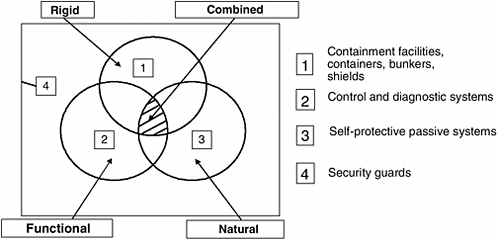
FIGURE 5 Types and systems of protection against accidents and catastrophes.
To protect elements of the engineered environment from terrorist-initiated actions and consequent extreme situations, the following types of protection systems are being studied and developed (see Figure 5):
-
rigid protection—protection requiring the expenditure of a large amount of energy to overcome
-
continuous functional protection—protection that in an accident or deviation from normal operational status for the elements of a complex technical system could take on certain system functions for a limited time or could prevent an accident from progressing further
-
natural protection—protection that involves the use of passive natural phenomena and processes aimed at curtailing accidents and reducing the level of impact factors
-
security guards
Circles 1, 2, and 3 stand for separate types of protection systems. Areas of intersection (1-2, 2-3, 1-3, and 1-2-3 correspond to a combination of correspondent types of protection systems. Security guards system 4 is organized to ensure protection of all the systems (1, 2, 3, 1-2, 2-3, 1-3, and 1-2-3).
Here the degree of protection against accident situations by all methods remains varied (see Table 2).
Regarding the problem of technological terrorism, in addition to the protection systems mentioned above there is also a specialized security protection system covering very high risk facilities, their personnel, and existing physical protective barriers. These security forces include the appropriate militarized and
specialized subunits equipped with weapons and military hardware and observation and warning systems. Combined protection unites the properties of intensive, functional, natural, and security personnel-based protection systems.
One of the most important factors in overcoming all of the types of terrorism discussed in this paper has been and remains that of direct counteractions against those who organize and carry out terrorist acts.
ADDITIONAL REFERENCES
General Council of the Russian Federation Scientific Research Institute of Problems of Reinforcing Law and Order. 2002. P. 134 in Terrorism and Transportation Security: A Compilation of Materials from an International Scientific and Practical Conference. Moscow: NII GP.
Makhutov, N. A., V. Osipov, and M. Gadenin. 2002. Scientific Basis for Ensuring Comprehensive Safety of Russia. Problems of Safety and Emergency Situations 6:13–21.
Makhutov, N. A., M. Segal, and V. Stepanchikov. 2004. Threats of Terrorism and Engineered Emergencies. Problems of Safety and Emergency Situations 2:85–93.
National Research Council. 2004. Pp. 227–228 in Terrorism—Reducing Vulnerabilities and Improving Responses: U.S.-Russian Workshop Proceedings. Washington, D.C.: The National Academies Press.
Russian Academy of Sciences-Russian Ministry of Emergency Situations. 2004. P. 313 in Problems of Technological Terrorism and Methods of Countering Terrorist Threats: A Compilation of Materials from a Scientific and Practical Conference. Moscow: Institute of Mechanical Engineering of the Russian Academy of Sciences.
Starostin, S. A. 2003. Modern Terrorism—a Threat to the National Security of the Russian Federation. Problems of Security in Extreme Situations 4:76–83.
Vorobiev, Yu., N. A. Makhutov, and G. Malinetky. 1998. Risk Theory and Technologies for Ensuring Safety: An Approach Based on Nonlinear Science. Problems of Safety and Emergency Situations 11:5–21.
Zmeevsky, A. V. 2002. Terrorism in a High-Tech Society: Legal Aspects and Conemporary Methods of Preventing and Countering Terroist Activity. P. 244 in High-Impact Terrorism: Proceedings of a Russian-American Workshop. Washington, D.C.: National Academy Press.
















